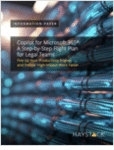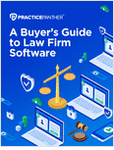Law firms’ profitability may be reaching an inflection point, a new survey published by BigHand finds. The report, which includes responses from 800 legal professionals at large law firms (100+ attorneys) across the U.K. and North America, shows an increased awareness of what is impacting firms’ bottom lines – with still some ways to go toward profit optimization.
More than half of all surveyed firms (53% in North America; 51% in the U.K.) reported facing heightened client demand for financial transparency. Accordingly, BigHand reports, law firms’ biggest priority is improving client communication throughout each matter – lest they face a billing dispute in which they are forced to compromise.
“One of the major changes we’ve seen in the industry in the last five years is that, as clients get more sophisticated, they have legal-operations departments – and as firms get more sophisticated, they have their pricing people,” said Rob Stote, Global Director of Financial Productivity Products at BigHand. “And having those two groups talk to each other . . . absolutely plays into write-offs reductions.”
Time vs. Money
 Rob Stote, Global Director of Financial Productivity Products at BigHand.
Rob Stote, Global Director of Financial Productivity Products at BigHand.
Almost every firm surveyed raised billable-hours targets in the preceding year; nearly half reported raising billable-hour targets by more than 10%.
But firms have also raised the number of billable hours for which they do not, in fact, actually bill.
Most law firms (75% in North America; 64% in the U.K.) reported an increase in write-offs in the past year. These increases are, as the report puts it, “spiraling.” In fact, 55% of North American firms and 48% of U.K. firms reported that their write-offs increased by more than 10% during this time.
Write-offs represent the largest source of profit leakage for about 3 out of 10 firms, according to the survey.
The message is clear: Law firms need to work smarter, not harder, to increase profits.
“Yes, it’s important to have your billable-hour targets,” said Stote. “But at the end of the day, your collections are the most important piece. Are you getting paid for the piece of work you’ve done?”
Seeing and Understanding
Firms are increasingly working on improving internal data visibility.
About 20% of firms reported that they plan to review collections write-offs and write-downs; about the same number plan to review billing write-offs and write-downs. Many firms (44% in North America; 31% in the U.K.) plan to improve management and partners’ visibility into lock-up data. And about 30% are implementing new approval processes for write-offs – in a bid to favor consistency over the discretion of individual managers who may not understand the implications downstream.
This latter development underscores the fact that visibility is nothing without understanding. As such, about 20% of law firms plan to provide pricing training to their fee-earning staff.
Stote emphasized that to be effective, this understanding of the relationship between profitability and matter-level data must extend beyond partnership and senior management.
“Firms have some work to do internally to make sure that they’re raising the level of financial acumen [among] their lawyers,” said Stote. “One of the biggest shifts we’ve seen over the last couple of years is that it’s become more and more the responsibility of everybody at the firm to understand profitability.”
Joe Stanganelli is a writer and recovering attorney. He is managing director of content advisory Blackwood King LC.
To find out more or access the full BigHand report, download the report.
NOT FOR REPRINT
© 2024 ALM Global, LLC, All Rights Reserved. Request academic re-use from www.copyright.com. All other uses, submit a request to [email protected]. For more information visit Asset & Logo Licensing.


 In a recent survey, almost every law firm raised billable-hours targets in the preceding year; nearly half reported raising billable-hour targets by more than 10%.
In a recent survey, almost every law firm raised billable-hours targets in the preceding year; nearly half reported raising billable-hour targets by more than 10%.






